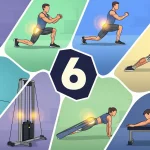Ever noticed how 5 km on a treadmill feels easy, but 5 km on the road makes your legs shake?
Fit People, have you experienced this?
- A chill 5K on the treadmill? No problem.
- A 5K run on a track? Still smiling.
- A 5K jog through the neighborhood? 3 km in, and it already feels like you’ve climbed a mountain.
Same distance, almost the same time — but it feels completely different. Why?
The answer lies in a factor we often overlook: Elevation Gain.
So, What Exactly Is Elevation Gain?
In simple terms, Elevation Gain is the total vertical height you climb during an activity.
Not just the final peak you reach, but the accumulated elevation throughout the entire route.
Simple example:
- Run 5 km on flat ground = elevation gain: 0 m
- Run 5 km through rolling hills = elevation gain: 100–200 m, depending on how many inclines there are.
Even if the distance is the same, the effort is wildly different. Elevation forces your body to work harder.
Why Elevation Gain Impacts Your Body More Than You Think
Now imagine this:
- You carry a 5 kg backpack on flat ground — manageable.
- Carry the same bag uphill — suddenly exhausting.
That’s the effect of elevation gain. Here’s why it matters:
1. Boosts Cardiovascular Capacity
The steeper the incline, the harder your heart and lungs must work.
A 2014 study in the Journal of Strength and Conditioning Research found that every 5% increase in gradient can raise your heart rate by 10–15%, compared to running the same distance on flat terrain.
2. Strengthens Leg Muscles & Stabilizers
Inclines activate:
- Quadriceps
- Hamstrings
- Glutes
- Calves
- Ankle and core stabilizers
That’s why trail runners and hikers often have rock-solid legs — even without lifting heavy weights in the gym.
3. Improves Balance and Coordination
Uphill and downhill paths force constant micro-adjustments in your body:
- Foot placement
- Hip activation
- Lower back control
This dynamic posture is incredibly useful for daily life and injury prevention.
4. Burns More Calories
If you’re aiming for fat loss, elevation gain is your hidden weapon.
According to Harvard Health Publishing, brisk uphill walking burns 30–50% more calories than walking at the same pace on a flat surface.
Not Just for Trail Runners
You don’t have to be an ultra runner or mountain climber to benefit from elevation gain. It naturally occurs in daily activities like:
- Casual hiking
- Stair climbing
- Walking on an incline treadmill
- Jogging in a hilly neighborhood
- Cycling through hilly terrain
Without even realizing, you’re training elevation gain in your daily routine.
Tips for Safe Elevation Gain Training
- Start light: A 3–5% incline is enough for beginners.
- Shorten your stride: Long strides on inclines will tire you out fast.
- Strengthen support muscles: Do single-leg squats, calf raises, and core stability work.
- Don’t skip recovery: Foam rolling and stretching for calves and hips are essential.
- Train downhill too: Eccentric strength is critical for knee and quad control.
Common Mistakes with Elevation Gain
- Increasing incline too quickly
- Skipping lower-body strength training
- Ignoring breathing technique
- Chasing elevation stats on Strava without proper recovery
Conclusion: Elevation Gain Is the Hidden Upgrade in Your Workout
If your routine feels flat — literally — elevation gain can give it a new edge.
- Stronger heart
- More powerful legs
- Better endurance
- Improved body control
If you’re into fun football like I am and want to step up your game a little, try elevation gain training. It worked for me. I used to burn out in 20 minutes. Now I can play a solid 30 minutes nonstop.
But remember, don’t sprint uphill until your body is ready.
At Focus Fit, we always teach that progress isn’t about training the hardest, but adapting the smartest.
Because #StayFocs isn’t just about being strong. It’s about being smart with your growth.
References:
- Journal of Strength and Conditioning Research, 2014. Physiological Responses to Uphill Running
- Harvard Health Publishing, 2020. Calories Burned in 30 Minutes for People of Three Different Weights
- ACSM’s Guidelines for Exercise Testing and Prescription, 2021





